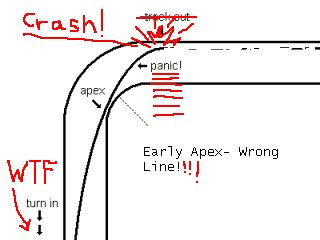Rique... There are a few options after you have gone wide.:
1. Keep trying to make the corner anyway. As was pointed out by Kismet and a couple of others. Most riders don't really understand how much lean angle their Bikes can REALLY get away with; this is why trackdays are so good for your riding skills, it teaches you how much lean angle you can carry for real. Sometimes you just grit your teeth and lean more and you WILL make it round the corner.
2. If there is runoff and you can see through the corner and there is no oncoming traffic, then you can get the bike upright, brake just enough to scrub enough speed off to make the corner, then get back into the corner again; I have done this on occasion where I come though a corner and find a big piece of debris in the way.. I flick the Bike upright to steer round the object, get on the brakes while I am upright, recalculate the new line through the corner, then get the Bike back down into the corner and make it.
3. If all is truly lost and you know you are fu(ked. As others have said, choosing your own poison can be the least bad of all the bad options available to you. A low speed lowside can be the best outcome for both you and the Bike. Obviously, if there is oncoming traffic, this option can get you killed.
4. I have bailed on a corner by basically looking for oncoming traffic and looking for a safe way to go ahead of me. About 18 years ago, I was on my GSXR 1100, I was too early on my apex in a right hander, but I could see through it. I realized I had screwed the corner up and saw a gravel pullout/passing cutout on the other side of the road. I flicked the Bike up right, got HARD on the brakes to scrub off as much speed as I could while I was still on asphalt, then as soon as I was about to hit the gravel, I let off the brakes a bit (but still kept a bit of pressure on the front lever) and managed to stop before the edge of a small cliff. The Bike stayed upright and I was ok, other than needing a change of underwear.
Mostly, you should remember that on the street, you should NEVER, EVER ride at 100% of your abilities!!! It leave zero room for unanticipated problems like road debris, wild animals, wet patches in the shade, etc, etc. Keep your adrenaline, testosterone and ego in check and don't over-ride your Bike. If you go on group rides with friends that are way faster than you, don't try to keep up, that's a recipe for disaster. They should wait for you at major intersections or where you plan to stop next.
Do a few track days and get a real understanding of the limits of yourself and your Bike. Work on your skills and ride with people who are better and faster than you are (without riding in a pack of lunatics who are going to ride as if the public roads are Laguna Seca Raceway).
I learned exactly this way. Rode with some AFM racers, one of whom rode a Honda 400 and kicked everyone's ass in the corners, especially on the downhills, I did the Keith Code SuperBike school and also Bob Bondurant Car and Shifter Kart schools as well as Skip Barber and a couple of others as well. I also started Club Racing in both Cars and on Motorcycles.
I have been a Race Car driving instructor for the last 17 years, but I still refresh my own skillset every couple of years.







